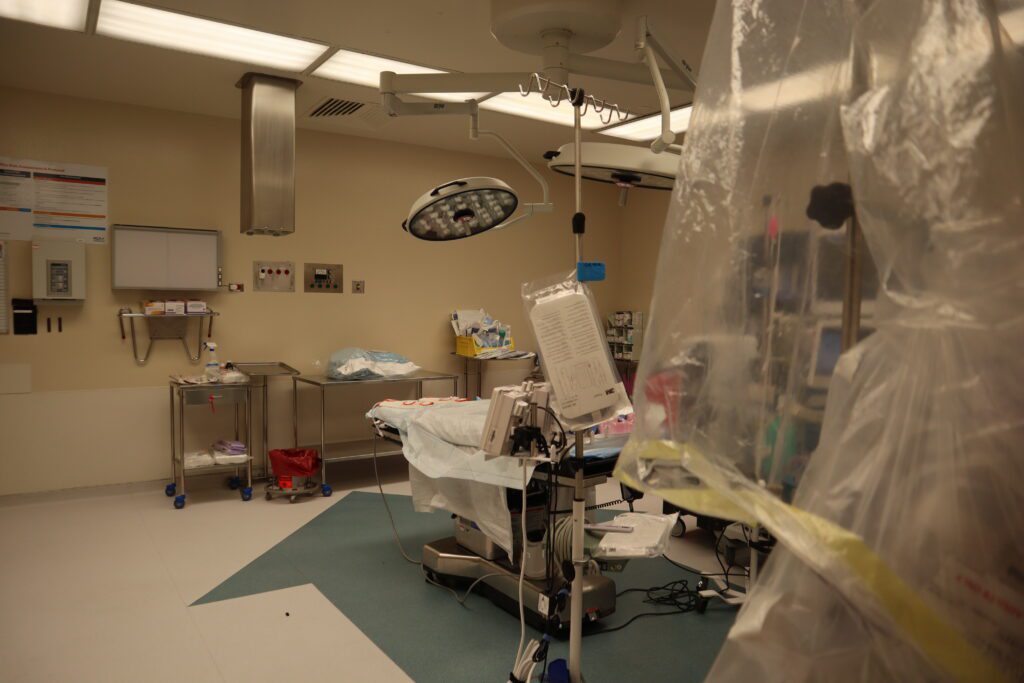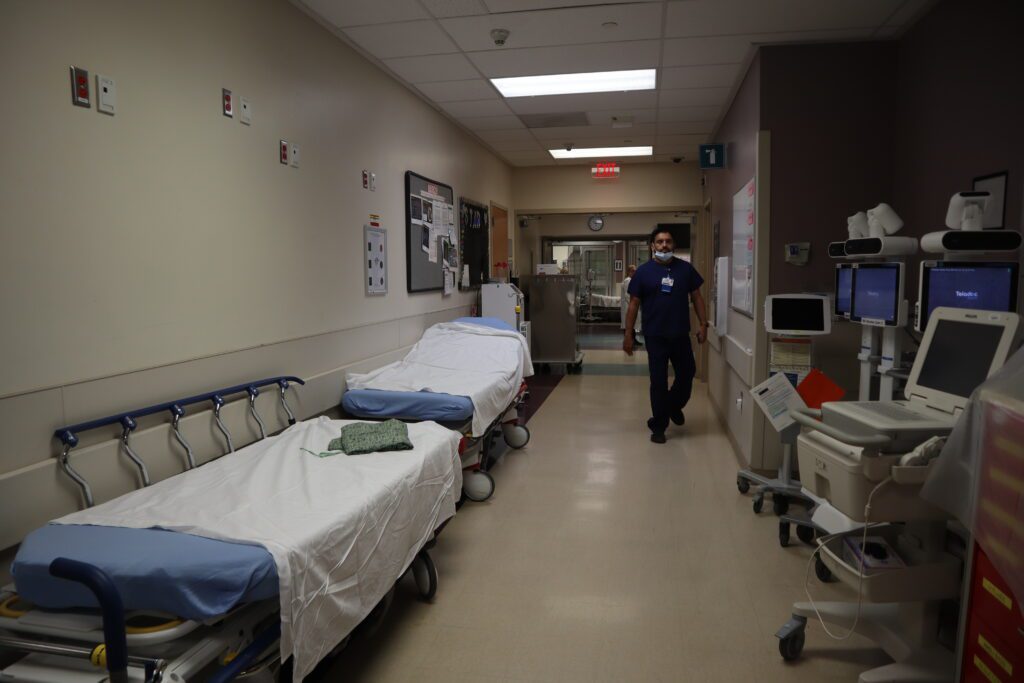Workers at Regional Medical Center’s trauma unit routinely cut car crash victims out of their clothes, replace blood as it sprays from torn aortas and hold pelvic bones together as they pass along instructions over the yelling of suffering patients.
Commotion and stress aren’t exactly positive features of most workplaces. But for an East San Jose hospital recovering from years of devastating service cuts, they’re welcome signs that one of the region’s only two trauma centers is working as it should.
It’s a much different sight, under Santa Clara County ownership, compared to the eerily quiet trauma center described by workers under previous corporate owner HCA Healthcare. Before the county’s purchase last year, the hospital steadily slashed its trauma, stroke, heart attack and maternity care until they were gone or running on fumes — overburdening other hospitals and dragging out wait times for treatment.
“You saw staff not as engaged since there wasn’t much going on. There were probably about 70 patients admitted to the hospital,” Yvonne Karanas, Regional Medical Center’s physician executive, told San José Spotlight. “But now — our census yesterday was about 193 patients. You can see almost three times what we were seeing in March.”

Karanas, who held a previous stint at the county’s flagship public hospital, Valley Medical Center, said she felt compelled to join Regional for several reasons. Chief among them is what she witnessed after HCA slashed Regional’s trauma center — which served a quarter of all county trauma cases — last August. The company’s decision forced Regional to divert patients to Valley Medical Center. As a consequence, Valley Medical Center reported seeing the highest patient volume of any trauma center in California during 2024, with a total of 5,196 cases.
“It just wasn’t sustainable. Not only for the staff capacity but the physical space, the equipment to manage that kind of volume,” Karanas said. “It was very clear that we needed to buy Regional to bring back those services so we could continue to maintain care across the entire system, the level of care that we wanted to provide to the community.”
County leaders purchased Regional for $150 million from HCA Healthcare — despite a massive structural budget deficit — following waves of profit-driven service cuts that threatened to turn Eastside working-class neighborhoods into a major health desert. The purchase made it the fourth hospital in the county health care system.
On top of restoring the Level 2 trauma center, the county also revived the hospital’s lifesaving heart attack and stroke centers. Next month, the county plans to reopen Regional’s maternity ward after its controversial closure in 2020.
Regional Medical Center sits at the intersections of Highways 101 and interstates 680 and 280 — encircled by dangerous intersections and wide arterial roads where cars blow by at highway speeds. Most of the hospital’s trauma center patients arrive due to blunt trauma injuries from car crashes, Karanas said.
“Oftentimes, in particular with blunt trauma, there’s a lot of need for orthopedic surgery and nerve surgery, so the attending surgeon may call consultants and coordinate care with them so those services can arrive to the Emergency Department as well,” Karanas said.
And in this East San Jose neighborhood of multigenerational Vietnamese and Latino families, a translator is another critical part of the system when it comes to quick decisions and trust.
Trauma centers have a number of requirements to be certified, including having a panel of sub-specialists — physicians who have advanced training in a specific area of medicine. Karanas said Regional has a much larger panel of sub-specialists now than under private ownership.
Regional’s trauma unit is classified as a Level 2 trauma center, which is able to initiate care for all injured patients, while Valley Medical Center’s trauma unit is a Level 1 — capable of providing total care from prevention through rehabilitation. Prior to the county’s purchase, HCA last year moved to downgrade Regional’s trauma center to a Level 3, a designation typically reserved for rural area hospitals.

More trouble in sight
Luis Maciel, a registered nurse and Regional’s trauma program coordinator, said it was slower under HCA’s downgrading. But that didn’t mean people stopped needing care.
“It was also a time where patients would come here, not knowing we stopped providing certain services, and we would have to transfer them out to another hospital. In trauma we have what we call a ‘golden hour,'” Maciel told San José Spotlight.
The golden hour is the period of time immediately after a traumatic injury where there is the highest likelihood that prompt treatment prevents death.
“Previously we would have to wait sometimes six hours to transfer them out,” Maciel said.
 Locals are celebrating the investment into their neighborhood. But more trouble is around the corner.
Locals are celebrating the investment into their neighborhood. But more trouble is around the corner.
Santa Clara County’s network of four hospitals and 15 health clinics — the second largest public health care system in the state after Los Angeles County — is mostly reliant on Medicaid reimbursements. Now billions in federal spending reductions could deal a major blow. Officials warn President Donald Trump’s July 4 signing of H.R.1, the “big beautiful bill,” will lead to $4.4 billion in Medi-Cal revenue losses to the hospital system over the next five years. This is not a loss the county can budget through without major county spending cuts to the health care system — which is roughly 30% of the county’s $14 billion budget.
On Nov. 4, county officials will ask voters to support a five-eighth-cent sales tax increase, estimated to bring in $330 million in new revenue annually.
Community health and patient advocates from East San Jose are rallying around the measure. That includes community group La Raza Roundtable, whose co-founder Rose Amador warned against cuts similar to what was witnessed at Regional.
“Preserving these services is not just a matter of fiscal responsibility; it is a moral imperative to uphold the health and dignity of every resident in our County,” Amador wrote in a Monday letter to residents.
Contact Brandon Pho at [email protected] or @brandonphooo on X.



Leave a Reply
You must be logged in to post a comment.